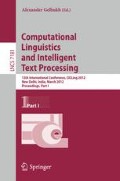Abstract
An unsupervised, knowledge-based, parametric approach to Word Sense Disambiguation is proposed based on the well-known cognitive architecture ACT-R. In this work, the target word is disambiguated based on surrounding context words using an accumulator model of memory search and it is realized by incorporating RACE/A with ACT-R 6.0. In this process, a spreading activation network is built following the strategies of Tsatsaronis et al. proposed in [5] using the chunks and their relations in the declarative memory system of ACT-R and the lexical representation has been achieved by integrating WordNet with the cognitive architecture. The resulting Word Sense Disambiguation system is evaluated using the test data set from English Lexical Sample task of Senseval-2 and overall accuracy of the proposed algorithm is 44.74% which outperforms all the participating Word Sense Disambiguation Systems.
Access this chapter
Tax calculation will be finalised at checkout
Purchases are for personal use only
Preview
Unable to display preview. Download preview PDF.
References
Collins, A.M., Loftus, E.F.: A spreading activation theory of semantic processing. Psychological Review 82(6), 407–428 (1975)
Emond, B.: WN-LEXICAL: An ACT-R module built from the WordNet Lexical database. In: Proc. of the Seventh International Conference on Cognitive Modelling, Trieste, Italy, pp. 359–360 (2006)
Melamed, D., Resnik, P.: Melamed and Resnik’s Proposal for Senseval scoring (October 8, 2011), http://www.cse.unt.edu/~rada/senseval/senseval3/scoring/scorescheme.txt
Meyer, D.E., Schvaneveldt, R.E.: Facilitation in recognizing pairs of words: Evidence of a dependence between retrieval operations. Journal of Experimental Psychology 90(2), 227–234 (1971)
Tsatsaronis, G., Vazirgiannis, M., Androutsopoulos, I.: Word Sense Disambiguation with Spreading Activation Networks Generated from Thesauri. In: Proc. of IJCAI 2007, pp. 1725–1730 (2007)
Miller, G.A., Beckwith, R., Fellbaum, C., Gross, D., Miller, K.: WordNet: An online lexical database. Int. J. Lexicograph 3(4), 235–244 (1990)
Berger, H., Dittenbach, M., Markl, D.: An adaptive information retrieval system based on associative networks. In: Proc. of the 1st Asia-Pacific Conference on Conceptual Modelling, Dunedin, New Zealand, pp. 27–36 (2004)
Anderson, J.R.: Language, Memory, and Thought. Lawrence Erlbaum and Associates, Hillsdale (1976)
Anderson, J.R.: A Spreading Activation Theory of Memory. Journal of Verbal Learning and Verbal Behavior 22(3), 261–295 (1983)
Anderson, J.R., Lebiere, C.: The atomic components of thought. Erlbaum, Mahwah (1998)
Anderson, J., Bothell, D.: Tutorials and Reference Manual of ACT-R (2011), http://act-r.psy.cmu.edu/actr6/
Veronis, J., Ide, N.M.: Word sense disambiguation with very large neural networks extracted from machine readable dictionaries. In: Proc. of COLING 1990, Helsinki, Finland, pp. 389–394 (1990)
Van Maanen, L., Van Rijn, H.: RACE for retrieval: Competitive effects in memory retrieval. In: Proc. of 12th Annual ACT-R Workshop, 12th edn., Triests (2005)
Van Maanen, L.: Context effects on memory retrieval: Theory and applications. PhD thesis, University of Groningen, Groningen (2009)
Lesk, M.: Automatic sense disambiguation using machine readable dictionaries: How to tell a pine cone from a ice cream cone. In: Proc. of SIGDOC (1986)
Ross Quillian, M.: A design for an understanding machine. In: Communication Presented at the Colloquium Semantic Problems in Natural Language. Kings College, Cambridge University, Cambridge, United Kingdom (1961)
Ross Quillian, M.: A semantic coding technique for mechanical English paraphrasing. Internal memorandum of the Mechanical translation Group. Research Laboratory of Electronics, M. I. T (August 1962)
Ross Quillian, M.: Word concepts: A theory and simulation of some basic semantic capabilities. The Journal of Behavioral Science 12, 410–430 (1967)
Ross Quillian, M.: Semantic memory. In: Minsky, M. (ed.) Semantic Information Processing, pp. 227–270. MIT Press (1968)
Ross Quillian, M.: The teachable language comprehender: a simulation program and theory of language. Communication of ACM 12(8), 459–476 (1969)
Byrne, M.D., Anderson, J.R., Qin, Y., Bothell, D., Douglass, S.A., Lebiere, C.: An Integrated theory of the mind. Psychological Review 111(4), 1036–1060 (2004)
Usher, M., McClelland, J.L.: The time course of perceptual choice: The leaky, competing accumulator model. Psychological Review 108(3), 550–592 (2001)
Ide, N., Veronis, J.: Word Sense Disambiguation: the state of the art. Computational Linguistics 24(1), 1–40 (1998)
Edmonds, P.: Designing a task for SENSEVAL-2 (2000), http://www.sle.sharp.co.uk/SENSEVAL2/archive/index.html
Edmonds, P., Cotton, S.: SENSEVAL-2:Overview. In: Proc. of The Second International Workshop on Evaluating Word Sense Disambiguation Systems (SENSEVAL-2), Toulouse, pp. 1–6 (2001)
Navigli, R.: Word sense disambiguation: a Survey. ACM Computing Surveys 41(2), 1–69 (2009)
Ratcliff, R., Smith, P.L.: A comparison of sequential sampling models for two-choice reaction time. Psychological Review 111(2), 333–367 (2004)
Satanjeev, B., Pedersen, T.: An Adapted Lesk Algorithm for Word Sense Disambiguation using WordNet. In: Proc. of the Third International Conference on Intelligent Text Processing and Computational Linguistics, Mexico City, pp. 136–145 (2002)
Chklovski, T., Mihalcea, R., Pedersen, T., Puradare, A.: The Senseval-3 multilingual English-Hindi lexical sample task. In: Proceedings of the 3rd International Workshop on the Evaluation of Systems for the Semantic Analysis of Text, Barcelona, Spain, p. 58 (2004)
Author information
Authors and Affiliations
Editor information
Editors and Affiliations
Rights and permissions
Copyright information
© 2012 Springer-Verlag Berlin Heidelberg
About this paper
Cite this paper
Dutta, S., Basu, A. (2012). A Cognitive Approach to Word Sense Disambiguation. In: Gelbukh, A. (eds) Computational Linguistics and Intelligent Text Processing. CICLing 2012. Lecture Notes in Computer Science, vol 7181. Springer, Berlin, Heidelberg. https://doi.org/10.1007/978-3-642-28604-9_18
Download citation
DOI: https://doi.org/10.1007/978-3-642-28604-9_18
Publisher Name: Springer, Berlin, Heidelberg
Print ISBN: 978-3-642-28603-2
Online ISBN: 978-3-642-28604-9
eBook Packages: Computer ScienceComputer Science (R0)

